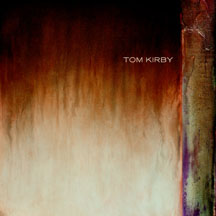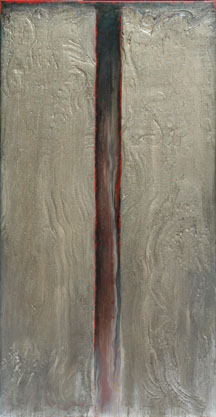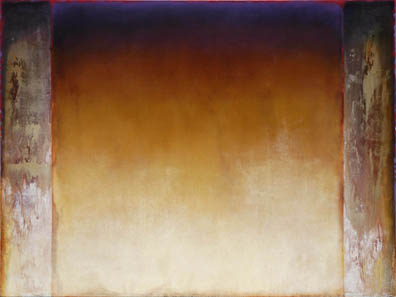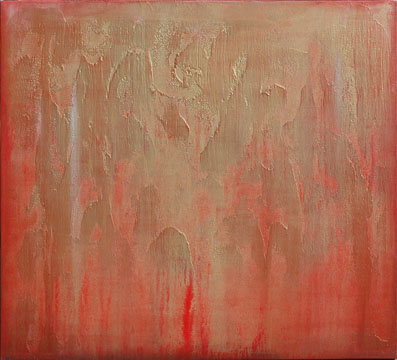|
when light falls
Main essay of Tom Kirby: Light Passage
by Kristin Barendsen
Light behaves differently when encountering a Tom Kirby painting. It scatters, hovers, and pools over the canvas, until subtle layers of light seem to form the substance of the work itself, like veils. As the angle or source of light changes—bright sun, incandescence, a candle flame—the painting it illuminates will markedly change character and mood, becoming almost another piece entirely. Kirby has distilled his understanding of paint to an understanding of light.
Kirby’s abstract works, on canvas and linen, captivate both eye and mind with their fine gradations of sheen, texture, and hue. Over a bold acrylic underpainting, Kirby applies up to 30 thin, transparent layers of acrylic wash and oil glaze. Ground metallic particles dispersed into the glaze cause optical interference, creating a violet iridescence that jumps beyond the painting’s surface. Drying glazes crack, forming reticulated fissures that expose the history of layers underneath. Kirby sands back the glazes, redefining the surface again and again, leaving them delicate enough in places to amplify the weave of the canvas or other subliminal textures.
|
 |
 |
|
 |
 |
In Apotheosis 5 (page 9), Kirby’s largest single-panel painting to date, a deep red-violet fades to azure blue, falls to silvery gray, and finally drips into Naples yellow, as a dark cadmium licks at the edges. Each layer is opalescent with mica, manganese, copper, or powdered amber, and the absence of a final varnish leaves a crackling rawness. They are a palpable record of Kirby’s ceaseless experimentation with the alchemy of his materials. Much depends on the angle of incidence: When the observer’s point of view lies along the trajectory of light, the base coat of Davy’s gray and the darker blues predominate; we perceive that the red-violet delineates a horizon line and we are viewing a cross-section of the Earth’s crust. But when the angle is oblique, the light plays across the surface, animating the painting’s hues of silver and yellow and bringing out volume and depth. The canvas becomes a vast expanse of sky, electric blue after a snow.
If light adds a third dimension to a Kirby painting, the passage of time adds a fourth: the piece changes as the sun sets and incandescent lamps are lit, or as the viewer walks from one edge of the canvas to the other. Each transformation resolves into a little epiphany, or, as Kirby likes to say, a satori, the Japanese term for a flash of sudden enlightenment.
Kirby employs recurring motifs of Classical architecture and geometry, such as the circular element (mathematical perfection, the rising sun) that appears throughout the Satori series. In many works, especially within the Fate series, column-like bands anchor the outer edges of the composition. Inspired by Kirby’s encounters with the monuments of Rome, Japan, and Istanbul, they evoke the walls of ancient structures peeling and crumbling. The columns seem to slowly advance, then recede, as our perception shifts.
|
|
In Immortality 4 (page 29), these columns become a portal from the physical world into limitless space. Of the title, Kirby says, “When you look at the sky, you have a sense of infinite recess. You come to a point that’s beyond the mind. Only when the mind stops its constant chatter can we arrive at our true nature, beyond our mortality.” We are drawn toward the source of luminosity, toward an emptiness full of a brilliant light, perhaps the light said to greet those near death. There’s something exquisitely silent about this piece, inviting us to sit awhile and watch our experience of it evolve, as we would a Rothko.
Kirby’s father, the late Thomas Kirby, Sr., was an Abstract Expressionist painter who studied directly with Mark Rothko and Clyfford Still. In the fifties, the elder Kirby briefly lived with Rothko and his wife Mell in New York, and he socialized
|
 |
 |
|
|
 |
with Barnett Newman and other Color Field painters. Although the younger Kirby never met these storied figures, their legacy and inspiration are apparent in his work: Rothko’s transcendent expansiveness, Still’s use of thick impasto, Newman’s sense of composition. The elder Kirby, whose abstract portraits share more in common with De Kooning, mentored his son, teaching him about techniques and materials and giving him space to work in his studio.
Tom Kirby describes his own work as “the merging of Expressionism and Minimalism.” He gives free rein to his Expressionistic impulse within the first several layers: the emotion and spontaneity of his hand’s gestures as he applies the underpainting, the unpredictable texture and sheen of paint that he might thicken with sand or marble dust. He invites the happy accident by allowing the surface to crack and split, by letting the paint drip and flow, and by leaving wet paintings out in the rain and sun.
After achieving a desired texture, Kirby brings in the Minimalist impulse by sanding, glazing, making transparent, removing what is unnecessary, while retaining areas that show the history of the process. His repeated glazing ameliorates the underlying texture, creating, as he puts it, a “dialectic between the visceral and ethereal.”
The piece Enlightenment 4 (page 41) represents the apogee of that Minimalistic trend; Kirby has polished the surface to “a certain limit.” Here, Kirby creates a painted luminosity using an imperial shade of yellow from China’s Qing Dynasty, poured onto the canvas in a thick, glassy layer that bends light but is not iridescent. Bathed in rich sun colors, the canvas almost emanates warmth. The tripartite composition reads as three separate passages, rather than open space defined by columns.
Kirby’s current impulse is toward making more textural pieces, such as Foundations of the Earth 1 (page xx). We peer into a canyon formed by what might be a split glacier, as eddies and currents of air or water flow over and between the solid outcroppings. The painting is about, and formed by, the elements: It bears the marks of raindrops and rivulets from the day he left it out in a storm.
In this piece and in its sister painting, Foundations of the Earth 2 (page 23), the artist reverses the weight of his three-part composition, narrowing the middle section to a thin stripe in a nod to Newman’s “Zip” paintings. Foundations 2 also depicts a chasm, but one that is geothermal rather than icy—the center band could be lava, bubbling upward, as the earth sinks downward, pulled by gravity. The ground is a thick bronze mixture created by the alchemy of dispersed copper and marble dust, applied with palette knives and cloth; subtle flecks of green are the product of oxidation. Both Foundations pieces impart a sense of geological history, of persistence and endurance and passing away. Kirby was once in an earthquake in the Bay Area; he recalls the feeling of the earth unmoored beneath his feet, the instability and insecurity of something we presume to be solid.
Kirby’s son Che, 28 (he also has a son Chris, 26), says his father is neither an Expressionist nor a Minimalist, but an “Essentialist.” It’s an apt term that refers to Kirby’s exploration of nature’s essential elements in his themes and materials, and that perhaps also speaks to his Asian influences. A practicing Buddhist in a Japanese tradition, Kirby draws on Eastern aesthetics and philosophies, including the reconciliation of opposites: adding and detracting, space and ground, permanence and impermanence.
His paintings also recognize the essence and importance of the present moment, exploring, as Kirby puts it, “the action of meditative consciousness upon the events of life.” The factors that make up a painting—the afternoons he spent layering the canvas, the works that came before these in his artistic evolution, his travels among the art and architecture of the world—all come together, resolve spontaneously, when the viewer is present to observe its illumination with light. As Kirby writes, “The moment when light falls upon the surface of the painting is also the moment when the painting is complete.”

|
Kristin Barendsen ● Santa Fe, New Mexico ● cell: 505.946.7707 ● kbarendsen (at) gmail.com
|
|
|